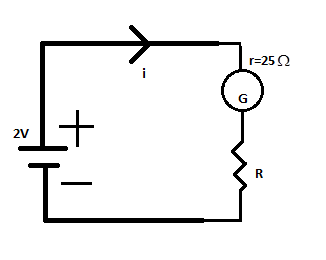Answer
64.8k+ views
Hint From the diagram, we can see that the battery, the galvanometer, and the resistance are in series with each other. The internal resistance of the galvanometer, $r$ is $25\Omega $. The initial resistance in series is $3000\Omega $. Thus we apply Kirchhoff’s Voltage Law in the above circuit to get the current flowing through the circuit. Next, we insert a new resistance $x$ in series with the previous resistance to get the new current flow.

Complete Step by step solution Applying Kirchhoff’s Voltage Law in the above circuit, we get
$2V = iR + ir$ .
The values of $R = 3000\Omega $, and $r = 25\Omega $ are given.
Substituting these values in the given equation, we get
$ \Rightarrow 2V = i(3000\Omega + 25\Omega )$
$ \Rightarrow i = \dfrac{2}{{3025}}A$
This value is described as $30units$ when the deflection of the galvanometer is at full scale.
Thus if $i = \dfrac{2}{{3025}}A = 30 units$ then
$1unit$ is $\dfrac{2}{{3025 \times 30}}A$.
Similarly, deflection $20units$ is equal to $\dfrac{{2 \times 20}}{{3025 \times 30}}A$current flow through the circuit which is the new current $I$ .
Thus keeping the numerator same, the denominator turns out to be
$\dfrac{2}{{3025 \times 1.5}}A = \dfrac{{2V}}{{4537.5\Omega }}$
; i.e. the denominator turns out to be $(4512.5 + 25)\Omega $.
We now get the required net resistance of the new circuit to be $4537.5\Omega $, which is including the internal resistance of the galvanometer.
This is because we can compare this equation with the K.V.L. equation of the new circuit, where $2V = I(r + R) = \dfrac{{2 \times 20}}{{3025 \times 30}}(25\Omega + R)$.
On further simplifying we get,
$ \Rightarrow 2 \times \dfrac{{3025 \times 30}}{{2 \times 20}} = 25 + R$
$ \therefore R + 25\Omega = (4512.5 + 25)\Omega $
Thus we get the required value of the new resistance $R$ as $4512.5\Omega $.
Therefore the correct option is not present in the given question.
Note A galvanometer measures the amount of current flowing through a given circuit. Here the galvanometer resistance is constant since we use the same galvanometer for both the readings. The value of the resistance $R$ changes as we wish to decrease the value of current passing through the galvanometer.

Complete Step by step solution Applying Kirchhoff’s Voltage Law in the above circuit, we get
$2V = iR + ir$ .
The values of $R = 3000\Omega $, and $r = 25\Omega $ are given.
Substituting these values in the given equation, we get
$ \Rightarrow 2V = i(3000\Omega + 25\Omega )$
$ \Rightarrow i = \dfrac{2}{{3025}}A$
This value is described as $30units$ when the deflection of the galvanometer is at full scale.
Thus if $i = \dfrac{2}{{3025}}A = 30 units$ then
$1unit$ is $\dfrac{2}{{3025 \times 30}}A$.
Similarly, deflection $20units$ is equal to $\dfrac{{2 \times 20}}{{3025 \times 30}}A$current flow through the circuit which is the new current $I$ .
Thus keeping the numerator same, the denominator turns out to be
$\dfrac{2}{{3025 \times 1.5}}A = \dfrac{{2V}}{{4537.5\Omega }}$
; i.e. the denominator turns out to be $(4512.5 + 25)\Omega $.
We now get the required net resistance of the new circuit to be $4537.5\Omega $, which is including the internal resistance of the galvanometer.
This is because we can compare this equation with the K.V.L. equation of the new circuit, where $2V = I(r + R) = \dfrac{{2 \times 20}}{{3025 \times 30}}(25\Omega + R)$.
On further simplifying we get,
$ \Rightarrow 2 \times \dfrac{{3025 \times 30}}{{2 \times 20}} = 25 + R$
$ \therefore R + 25\Omega = (4512.5 + 25)\Omega $
Thus we get the required value of the new resistance $R$ as $4512.5\Omega $.
Therefore the correct option is not present in the given question.
Note A galvanometer measures the amount of current flowing through a given circuit. Here the galvanometer resistance is constant since we use the same galvanometer for both the readings. The value of the resistance $R$ changes as we wish to decrease the value of current passing through the galvanometer.
Recently Updated Pages
Write a composition in approximately 450 500 words class 10 english JEE_Main

Arrange the sentences P Q R between S1 and S5 such class 10 english JEE_Main

What is the common property of the oxides CONO and class 10 chemistry JEE_Main

What happens when dilute hydrochloric acid is added class 10 chemistry JEE_Main

If four points A63B 35C4 2 and Dx3x are given in such class 10 maths JEE_Main

The area of square inscribed in a circle of diameter class 10 maths JEE_Main

Other Pages
A boat takes 2 hours to go 8 km and come back to a class 11 physics JEE_Main

Electric field due to uniformly charged sphere class 12 physics JEE_Main

In the ground state an element has 13 electrons in class 11 chemistry JEE_Main

According to classical free electron theory A There class 11 physics JEE_Main

Differentiate between homogeneous and heterogeneous class 12 chemistry JEE_Main

Excluding stoppages the speed of a bus is 54 kmph and class 11 maths JEE_Main



